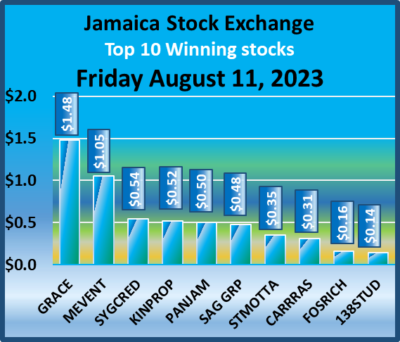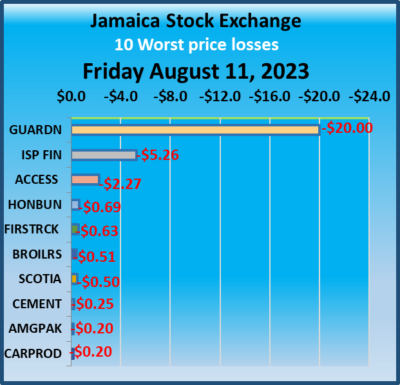All markets pulled back on the Jamaica Stock Exchange on Friday but for a minor movement upwards for the JSE USD Market following a drop in trading on the exchange.
 At the close, the JSE Combined Market Index lost 2,235.99 points to close at 335,575.18, the All Jamaican Composite Index dropped 2,943.11 points to 353,626.53, the JSE Main Index shed 2,292.56 points to settle at 321,234.17, the Junior Market Index dipped 10.58 points to finish at 3,915.47, while the JSE USD Market Index popped 0.14 points to close at 242.40.
At the close, the JSE Combined Market Index lost 2,235.99 points to close at 335,575.18, the All Jamaican Composite Index dropped 2,943.11 points to 353,626.53, the JSE Main Index shed 2,292.56 points to settle at 321,234.17, the Junior Market Index dipped 10.58 points to finish at 3,915.47, while the JSE USD Market Index popped 0.14 points to close at 242.40.
Preference share trading ended with notable price changes for Jamaica Public Service 7%, with a loss of $2 to $52 and 138 Student Living preference share that rose $8.50 to close at $93.48.
At the close, investors dealt in 12,495,973 shares in all three markets, down from 22,726,982 stocks on Thursday. The value of stocks traded in the Junior and Main Markets ended at $64.3 million, down sharply from $305.8 million on Thursday. Trading on the JSE USD market ended with investors exchanging 118,609 shares for US$17,580, compared with 1,054,854 units at US$35,623 on Thursday.
 The market’s PE ratio, the most popular measure used to determine the value of stocks ended at 17.4 on 2022-23 earnings and 11.7 times those for 2023-24 at the close of trading. ICInsider.com PE ratio chart and the more detailed daily report charts provide investors with regularly updated information to help decision-making.
The market’s PE ratio, the most popular measure used to determine the value of stocks ended at 17.4 on 2022-23 earnings and 11.7 times those for 2023-24 at the close of trading. ICInsider.com PE ratio chart and the more detailed daily report charts provide investors with regularly updated information to help decision-making.
The PE ratio chart covers all ordinary shares on the Jamaica Stock Exchange. It shows companies grouped by industry, allowing for easy comparisons between the same sector companies and the overall market. The EPS & PE ratios are based on 2023 and 2024 actual or projected earnings, excluding major one off items.
Investors need pertinent information to successfully navigate numerous investment options in the local stock market. The ICInsider.com PE ratio chart and the more detailed daily report charts provide investors with regularly updated information to help decision-making.
Investors should use the chart to help make rational decisions when investing in stocks close to the average for the sector and not going too far from it unless there are compelling reasons to do so. This approach helps to remove emotions from investment decisions and place them on fundamentals while at the same time not being too far from the majority of investors. Investors who buy when the price of a stock is close to the average will find that they are not inclined to overpay for a stock.
 The net asset value of each company is reported as a guide to assess the value of stocks based on this measure quickly. The chart also shows daily changes in stock prices and the percentage year to date price movement based on the last traded prices.
The net asset value of each company is reported as a guide to assess the value of stocks based on this measure quickly. The chart also shows daily changes in stock prices and the percentage year to date price movement based on the last traded prices.
Dividends paid or payable and yields for each company are shown in the Main and Junior Markets’ daily report charts along with the closing volume pertaining to the highest bid and the lowest offer for each company.
Prices fall on the Jamaica Stock Exchange
August 11, 2023 by IC Insider.com
Filed Under: Feature Stories, JSE Combined, Stock Market Tagged With: 138 Student Living, Daily Trading, Emerging market, Jamaica Stock Exchange, Jamaica Stock Exchange Combined Index, Jamaican stocks, JPS, JSE Main Index, junior market, Junior Market index, Net asset Value of Jamaican stocks, PE Ratio of Jamaican stocks, Productivity Business Solutions, Trading Activity
About IC Insider.com




